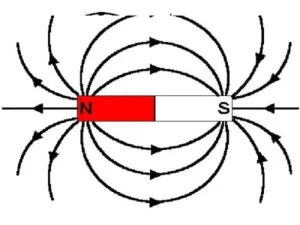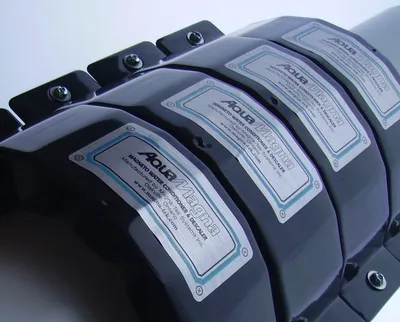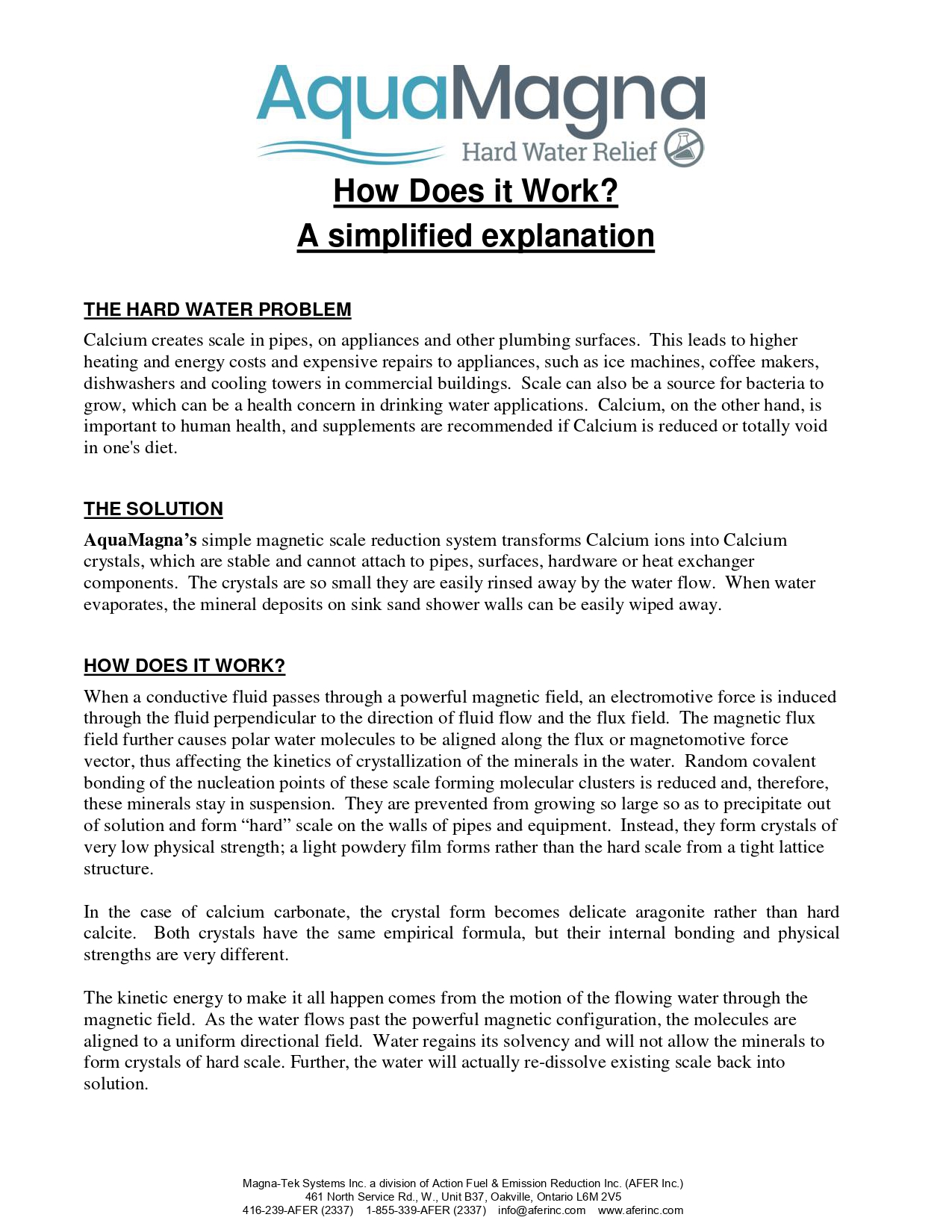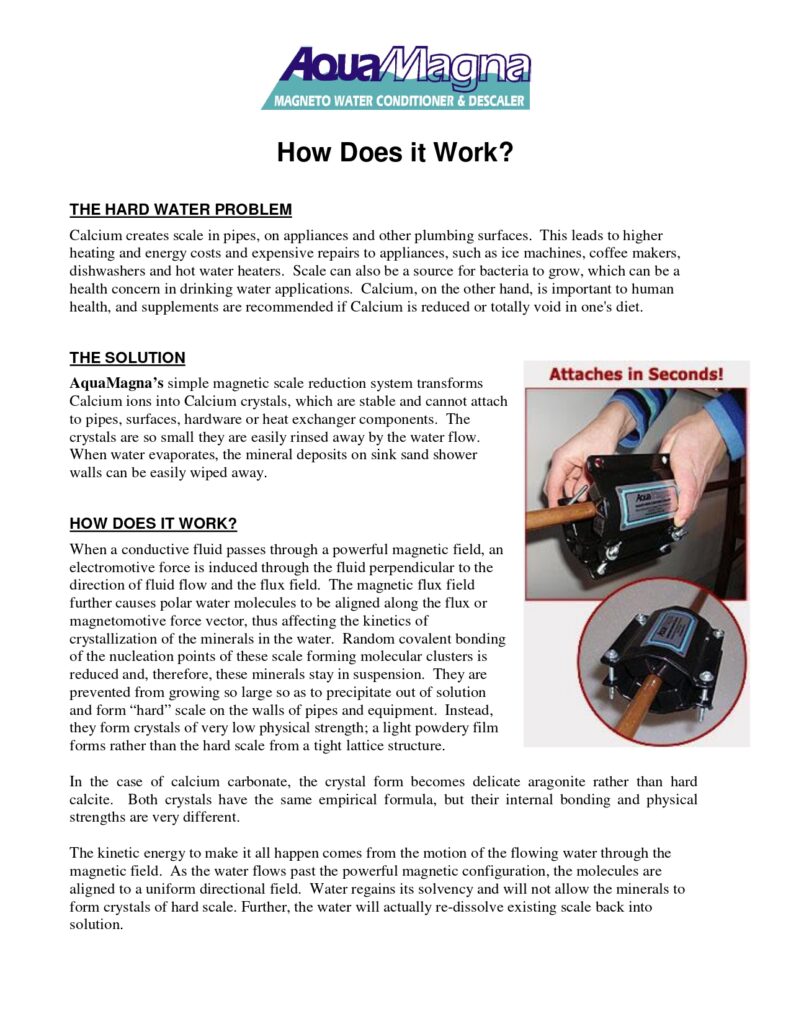MAGNETIC WATER TREATMENT

How does it Work?
Magnetic water treatment (otherwise known as magnetohydrodynamics or MHD) is nothing new. In the mid-eighteen hundreds, British scientist Michael Faraday made an important discovery: water flowing past a conductive material generates an electrical charge.

Magnetic Water Treatment (otherwise known as magnetohydrodynamics or MHD) is nothing new. In the mid-eighteen hundreds, British scientist Michael Faraday made an important discovery: water flowing past a conductive material generates an electrical charge.
The AquaMagna Hard Water Solutions saltless magnetic water softener is based on this very principle. Our high-strength barium ceramic magnets create a powerful magnetic field. When water flows past the powerful water magnets, it magnetizes the flowing fluid and disrupts the natural bonding of water molecules—altering the structure of the scale-forming minerals.
So when using the AquaMagna saltless magnetic water softener, the magnetic water changes the ionic form of hard water contaminates like calcium carbonate. Through simple physics, it keeps these particulates from crystallizing or in the form of lime scale. Instead, these molecules remain suspended in the flowing water while it passes through your plumbing system.
The kinetic energy to make it all happen comes from the motion of the water through the magnetic field. As the water flows past the powerful magnetic assembly, the molecules are aligned to a uniform directional field. Water regains it’s solvency and will not allow the minerals to form crystals of scale. Further, the water will actually re-dissolve existing scale back into solution.
Recent Developments
Despite its simplicity, magnetohydrodynamics is just beginning to gain popularity in North America. Advanced technology has led to stronger, more effective magnets. Continued study of this natural phenomenon has also enabled us to utilize its full potential.
THE HARD WATER PROBLEM
What is Hard Water?
The term hard water refers to a high mineral content. While it’s not an actual health risk, this particular type of water can be problematic. This is especially true for those individuals using well water.
Lime Scale: The build-up of lime scale is primarily caused by the calcium carbonate. Calcium is naturally absorbed by water as it streams over land and through rocks. When exposed to heat, from your water heater or stove top, the calcium molecules begin to accumulate. When the water evaporates, the crusty, white mineral deposits are left behind.
The amount of mineral content that water contains determines the hardness level of the water. Although the mineral content of household potable water is usually not harmful it can be problematic and undesirable.
Unlike traditional methods of treatment, the AquaMagna saltless magnetic water softener relies on the basic principles of physics, rather than salt or other harmful chemicals to soften your water supply.
Our environmentally friendly AquaMagna alternative to a salt water softener changes the way hard water contaminates like calcium crystallize—or forms lime scale. A short time after installation, calcium deposits become softer and are easier to clean from fixtures, sinks and kettles. Pipes and water appliances can become completely scale-free over time.
Magnetically conditioned water also feels fresher and cleaner. As calcium particulates remain suspended in the water while it flows through your pipes, they don’t stick to your dishes, hair or skin.
What problems does hard water cause?
Hard water can be problematic because it reacts with cleaning products, creates lime scale build-up, and can wear down fixtures and appliances quicker than soft water. The minerals in hard water may make cleaning products less effective so it makes cleaning more difficult. The build-up of those minerals on dishes, clothing, fixtures, and even skin and hair can take their toll over time.
What does hard water do to plumbing?
The build-up on tubs, shower, sinks, and faucets caused by hard water are only part of the problem. The minerals in hard water also start to build up inside pipes, fixtures and appliances over time. The build-up we don’t see can start to cause all sorts of plumbing problems like reduced water flow, clogs and increased stress on pipes and fixtures. The mineral deposits can cause appliances to operate less efficiently and wear down faster. Just imagine, the water heater has to heat all of the scale build up as well as the water. Overall, hard water results in less efficient plumbing and more repairs over time.
HARD WATER TREATMENT
SALT VERSUS “NO-SALT”
How does a salt water softener work?
A water softener uses a medium that serves to exchange “ions” of calcium and magnesium with sodium and potassium.
This occurs in four steps:
- To do the ion replacement, the water in the house runs through a resin bed of small plastic beads or zeolite. The beads are covered with sodium or potassium ions. As the water flows past the ions, they swap places with the calcium and magnesium ions. Eventually, the beads contain nothing but calcium and magnesium, and softening stops. It is then time to regenerate the beads or zeolite.
- To regenerate, the beads need to regain their sodium or potassium ions by being flooded with a salty, brine solution that is rich in sodium or potassium.
- Once completed, the calcium and magnesium, dirt and sediments are flushed from the beads and into the drain in a process called backwash.
- The final phase rinses the mineral tank with fresh water and loads the brine tank so it’s ready for the next cycle.
Advantages of salt water softeners
- Cleaner, softer feeling clothes
- Longer life of appliances including washing machine, dishwasher, and water heater
- Less use of household cleaning products, such as detergents, as well as personal cleanliness products, like shampoo
- Reduction of water spotting
Disadvantages of Salt water Softeners
- Softened water is not recommended for watering house plants, lawns and gardens due to its sodium content
- Water used in recharging a water softener may over load or reduce the effectiveness of small septic or sewer systems
- There may be health risks from sodium intake
- Softened water is not recommended for steam irons or evaporative coolers. The best choice for such appliances is distilled water or water from a reverse osmosis unit.
Health Risks Associated with Salt-Softened Water
During the softening process sodium is released from the exchange media into the output water. For every grain of hardness removed from water, 8 mg/1 (ppm) of sodium is added. People on restricted sodium intake diets should account for increased levels of sodium in softened water.

AquaMagna on 4 inch diameter pipe


